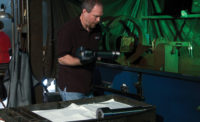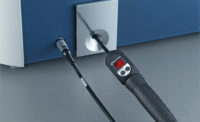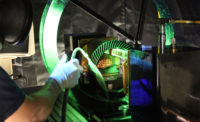Alfred V. de Forest and Foster B. Doane developed the magnetic testing method in the early 1930s and since then it has become a core method of nondestructive testing. Generations of NDT professionals have used this form of testing, and along the way, a handful of common misunderstandings have developed. This article explores these common and incorrect assumptions about magnetic particle inspection and how to combat these misunderstandings.
First and foremost, it is important to understand the composition of the parts being tested as not all metals are ferromagnetic and can be used in magnetic particle testing. Only iron, nickel, and cobalt can be magnetized. Most of their alloys and some forms of steel are also magnetic. Aluminum is used in an estimated 80% of aircraft materials today because it is lightweight, strong, predictable, and inexpensive. It is also one of the most common metals organizations attempt to test with magnetic particle inspection that cannot be magnetized.
Next, make sure to examine the carrier and particles during daily bath concentration checks as contamination is unavoidable no matter how clean you keep a space or parts. Unwanted contaminants such as oil, grease, sand, dirt, and other solids will be introduced to the bath by inspected components and can hinder testing performance and disguise indications. Make sure to look for differences in color, layering, or banding in either the carrier or the particles to spot contamination. If the test shows a band that fluoresces brighter than the bulk of the material, this is an indication that excessive unattached fluorescent pigments are present and that the bath should be changed.
When it comes to current, how much is used makes a big difference. More is not always better with magnetic particle testing since using more amps can saturate the field and mask defects. Fluorescent particles will be attracted to both the flux leakages (indications) and the whole part. Therefore, it is essential to work with an MT Level III to develop the correct part-specific testing methods that will create a sharp contrast with the background of the part and allow operators to spot indications easily.
It is critical to understand that materials do not all magnetize the same way, even if parts may look similar. If two similar-looking parts are made of different materials, they will also have different permeability and retentivity. Permeability affects how easily magnetic current travels through a part and how it is attracted to small flux leakages due to the flaws. The retentivity of a material affects how well the material holds its magnetic field. To ensure parts are correctly tested, always double-check the material and never assume the same techniques will work on similar-looking parts.
Pre-testing part cleaning is a key part of the testing process to ensure the highest probability of detection. Proper cleaning will decrease bath contamination and increase the visibility of indications on the part itself. Make sure to use a cleaner or remover to prepare parts before sending them to the magnetic particle testing area, a step that will improve the quality of inspections and reduce the number of times the bath will need to be changed.
For test pieces with coatings, ASTM E709-15 states, “Thin nonconductive coatings, such as paint in the order of 1 or 2 mil (0.02 to 0.05 mm) will not normally interfere with the formation of indications, but they must be removed at all points where electrical contact is to be made for direct magnetization.” Additionally, conduction coatings can mask discontinuities, and it must be demonstrated that the unacceptable discontinuities can be detected through the coating.
When looking for cracks in both the longitudinal and latitudinal directions, most machines require two shots since each shot the magnetic field produces will affect the other, erasing indications in one of the directions. However, there are two options to avoid firing two shots and inspecting a part twice. The first option is to only look for cracks in one direction which is a testing specification decided upon by a certified Level III and is dependent on the geometry of the part and intended application. The second option is to use a multi-directional mag bench. These benches have multiple phase circuitry that allows both directions of the magnetic field to be applied at the same time and without affecting each other. If high throughput is essential and inspection in both directions, then a multi-directional wet bench is the best option that can get the job done in one shot and with one UV lamp inspection.
Performing daily checks is required by ASTM and NADCAP and crucial to ensuring both the bath and machine are in proper working condition. Operators must check specific criteria such as bath concentration and UV lamp intensity each day or during every shift. Other quality checks, such as ambient white light, can play a significant role in an inspector’s ability to see indications. When daily checks are missed and machines and not calibrated correctly, parts are not magnetized, leading to a timely and expensive day of retesting parts.
Just like with electrical current, more isn’t always better. In this case, adding more particles does not make it easier to detect indications. Adding too many particles to a bath will add too much concentration and result in excessive background, making it harder to see minor defects. Instead, replace the entire bath and slowly add particles until the correct concentration is met.
Although a multi-directional unit may seem like the best option every time, the part themselves will determine which type of unit to use. When testing just a few parts, it may not be worth the time it takes to calibrate the machine for a multi-directional shot, and when processing a high volume of parts, using the same testing method, an MD unit may only cut testing time in half. It is better for complex parts in small volumes to use a standard mag particle inspection unit and perform two mag shots.
In summary, although there may be some common misunderstandings about magnetic particle testing out in the field, after reading this article, you now know how to correct these assumptions and share your knowledge with others in the industry. And when in doubt, always check with a certified Level III or contact your NDT product supplier.
Richard Ridenour is with Magnaflux.



